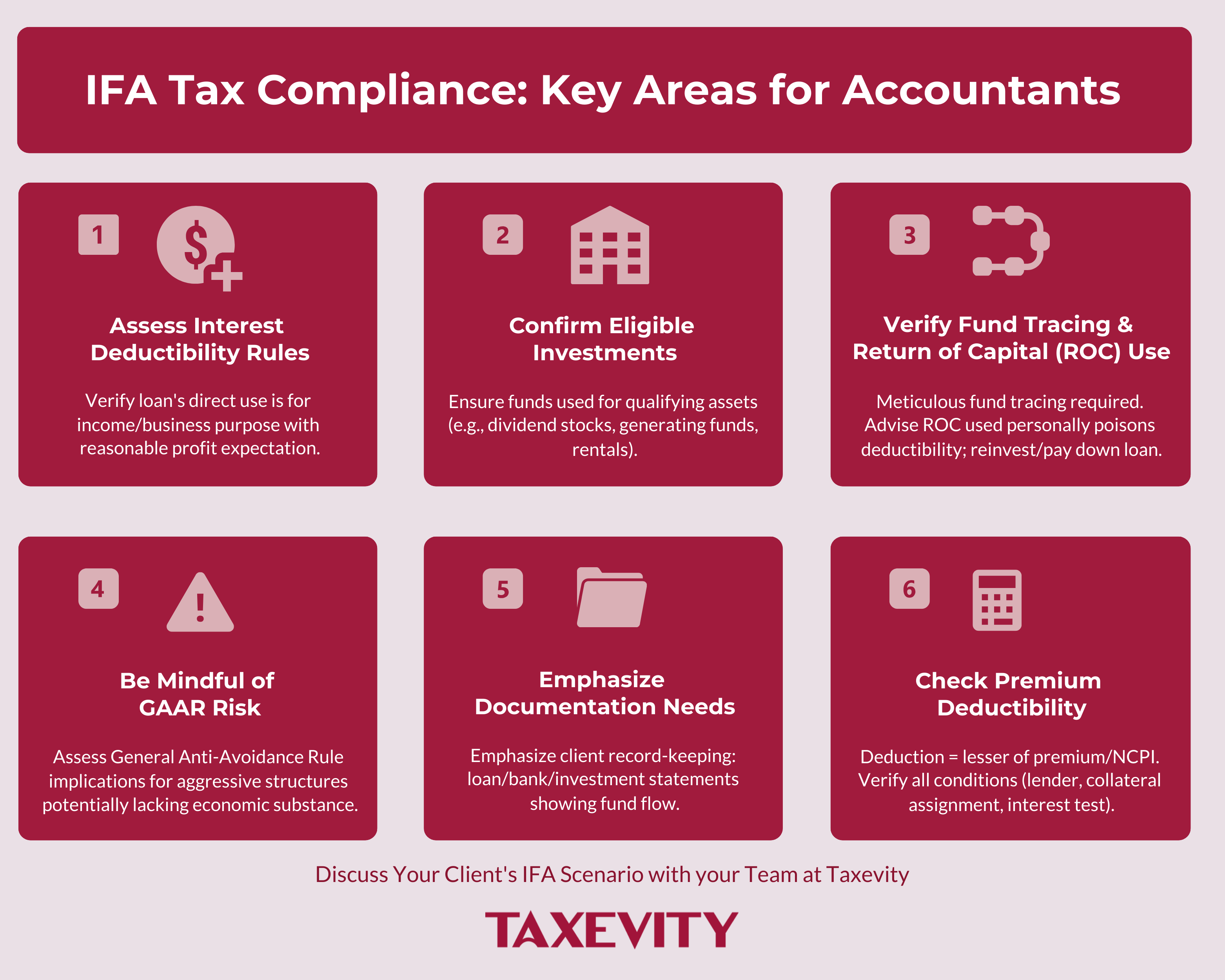Key Question for Accountants
As you are often your client’s trusted advisor, how do you perform effective due diligence on an Immediate Financing Arrangement (IFA) proposal to ensure it’s both suitable for the client and compliant with tax law?
- Tax Compliance Deep Dive: Your primary role is to verify the tax mechanics. This means ensuring the borrowed funds are traceably used for an eligible income-producing purpose and confirming the strict conditions for both loan interest and premium (NCPI) deductibility are met.
- Client Suitability Assessment: Look beyond the numbers to the client themselves. Do they have a legitimate reason for the insurance? Can they comfortably afford the premiums and service the debt? And do they have the right temperament and risk tolerance for a long-term leveraged strategy ?
- Scrutinize the Proposal: It’s crucial to challenge the assumptions used in any IFA model. Question the projected investment returns, the long-term interest rates used for the loan, and the tax rate assumptions to ensure they are reasonable and sustainable for your client.
As an accountant, you are often your client’s most trusted advisor, particularly when complex financial strategies arise. Immediate Financing Arrangements (IFAs) are increasingly common, leveraging life insurance for investment purposes. While potentially powerful, they carry significant risks and require careful scrutiny. This guide offers key considerations for ensuring IFA suitability and successful implementation, showing where partnering with Taxevity provides critical expertise for your clients. Understanding IFAs allows you to proactively protect your clients, add significant value through tax insights, and avoid potential pitfalls effectively.
Page Contents
- 1 Your Crucial Role: Beyond the Numbers
- 2 Deconstructing IFA Proposals: Look Beyond the Sales Pitch
- 3 Deep Dive: Tax Compliance & Due Diligence Checklist
- 4 Client Suitability Assessment: The Human Element
- 5 Lender and Policy Considerations
- 6 Collaboration is Key: How Taxevity Helps You
- 7 Proactive Value for Your Clients
Your Crucial Role: Beyond the Numbers
Clients may get intrigued by IFA proposals promising substantial returns and tax savings. Your role extends beyond verifying numbers to:
- Risk Assessment: Evaluating if the strategy aligns with the client’s true risk tolerance, financial capacity, and long-term objectives.
- Due Diligence: Scrutinizing the proposal’s mechanics, assumptions, and compliance with lender and regulatory requirements.
- Tax Compliance Guidance: Ensuring the structure meets CRA requirements for deductibility and advising on proper reporting (e.g., CDA). Your role typically involves advising the client on the need for meticulous record-keeping and fund tracing; the client is responsible for maintaining those records.
- Objective Advice: Providing a balanced view of the pros and cons, independent of any sales process.
Deconstructing IFA Proposals: Look Beyond the Sales Pitch
IFA proposals may feel like sales tools without the rigour and disclosure of official, CLHIA-compliant insurance illustrations (which typically don’t model the borrowing component). Key areas for scrutiny include:
- Unrealistic Assumptions: Challenge the projected investment returns, assumed long-term interest rates, and tax rates used. Are they reasonable and sustainable? Request sensitivity analysis showing impacts of lower returns or higher borrowing costs.
- Product vs. Strategy: Remember, your client is ultimately getting a standard whole life insurance policy. The IFA loan is a separate arrangement with a third-party lender, not the insurer (even if affiliated, like Manulife Insurance/Manulife Bank).
- Advisor Bias: Is the proposing advisor recommending the best insurer and policy structure for the client’s specific needs, or the one with the most attractive-looking proposal?
Deep Dive: Tax Compliance & Due Diligence Checklist
This is where your expertise is paramount to ensure stringent adherence to CRA requirements:
Interest Deductibility (ITA 20(1)(c)(i))
- Purpose Test: The direct use of the borrowed funds must be to earn income (dividends, interest) or for a business purpose, with a reasonable expectation of profit. Capital gains alone may not suffice.
- Tracing: Meticulous tracing of loan proceeds from the lender directly to the eligible investment is non-negotiable. A separate, dedicated investment account is highly recommended.
- Eligible Investments: Confirm the chosen investments qualify (e.g., dividend-paying stocks, mutual funds generating distributions, rental properties, business investments).
- Return of Capital (ROC): Advise clients that using ROC distributions for personal use can poison the deductibility of the associated portion of the loan interest. ROC should ideally be reinvested or used to pay down the loan.
- GAAR Risk: Be mindful of the General Anti-Avoidance Rule. While IFAs structured correctly are generally accepted, overly aggressive structures could potentially be challenged.
- Documentation: Ensure clients maintain thorough records: loan agreements, investment statements, bank statements demonstrating fund flow. Thorough documentation is essential, as the CRA requires clear evidence to support deductions.
For a comprehensive review of the legislative framework and CRA’s positions on interest deductibility for investment loans generally, see Accountant Companion: Navigating Canadian Interest Deductibility for Investment Loans.
Premium Deductibility (NCPI – ITA 20(1)(e.2))
- Strict Conditions: This deduction is narrower than sometimes portrayed. It requires:
- The lender must be a “restricted financial institution” (generally banks, credit unions, trust companies).
- The policy must be assigned as collateral for the loan.
- The loan interest must otherwise be tax-deductible (meeting the tests above).
- Calculation: The deduction is the lesser of premiums paid in the year and the Net Cost of Pure Insurance (NCPI) for the portion of the policy death benefit acting as collateral. It’s not simply a pro-rata share based on loan amount vs. cash value, nor is it typically 100% of the premium. Obtaining the correct NCPI figure attributable to the collateral from the insurer/advisor is key.
Capital Dividend Account (CDA)
- For corporately owned life insurance, the tax-free death benefit (less the policy’s Adjusted Cost Basis) creates a significant CDA credit upon the insured’s death.
- Ensure clients understand the value of the CDA for extracting funds tax-free from the corporation. Proper ownership structure (ideally a Holding Company owning the policy) and tracking are essential.
- An IFA creates Surplus CDA Capacity because the CDA credit is based on the gross death benefit before the loan is repaid, allowing the extraction of other corporate assets tax-free. For more see, The IFA-Enhanced CDA: A Foundational Guide for Accountants.
Client Suitability Assessment: The Human Element
- Financial Capacity: Can your client comfortably afford the substantial premiums for the policy’s duration without relying on the IFA loan itself? Do they have sufficient other income/assets?
- Taxable Income: Critically, does your client (or their corporation) have sufficient taxable income now and projected in the future to actually use the potential interest and NCPI deductions? Potential deductions offer little benefit if your client lacks sufficient taxable income to offset, although they can reduce income to zero or potentially be used against future income.
- Risk Tolerance & Temperament: Can your client emotionally handle market volatility affecting their leveraged investment and potential increases in loan interest rates? An IFA is a long-term strategy requiring discipline.
- Understanding Leverage: Do they truly understand the risks associated with borrowing to invest?
- Planning Rationale for Insurance: Is there a valid planning reason for the permanent life insurance (e.g., estate liquidity, funding buy-sell agreements, tax-efficient wealth transfer)? A strong planning rationale is required by insurers and reinforces the strategy’s legitimacy.
- Policy Ownership & Structure: If the policy is Joint Last-to-Die, how does the strategy impact the surviving spouse, who may not want or understand the ongoing leverage? Consider if single life policies might offer a simpler exit strategy upon the first death.

Lender and Policy Considerations
- Compare Lenders: Different lenders (banks, specialized non-bank lenders) have varying minimum loan amounts, Loan-to-Value (LTV) requirements, fees, collateral requirements (especially if borrowing 100% of premium), and underwriting standards. Your client’s existing banking relationship may be a starting point, but not always the best fit.
- Policy Structure: The way the whole life policy is structured (e.g., payment duration like 10-pay vs. Life Pay with offset) impacts cash value growth and potentially the NCPI calculation.
Collaboration is Key: How Taxevity Helps You
An IFA involves insurance, investment, legal, and tax complexities. You don’t have to be the expert in everything. Taxevity focuses specifically on the insurance and IFA structuring piece, working collaboratively with you. We provide:
- Objective Analysis: Reviewing proposals, providing compliant illustrations, and offering independent second opinions.
- Technical Expertise: Clarifying complex insurance mechanics and tax implications (like NCPI calculations).
- Actuarial Insight: Leveraging our background to ensure optimal policy structuring.
Partnering empowers you to confidently advise your clients, knowing the insurance component is handled with the same expertise and diligence they expect from you.

Proactive Value for Your Clients
By understanding the intricacies of IFAs and performing thorough due diligence, you can protect your clients from unsuitable arrangements and help them benefit from well-structured strategies. Being proactive in identifying clients who could appropriately use an IFA (those with high corporate passive income, significant retained earnings, or large estate tax liabilities) positions you as a high-value strategic advisor, solidifying your client relationships.
Ready to confidently navigate your next client IFA query? Contact your family team at Taxevity to discuss a specific client case, review an IFA proposal, or learn more about how we support accountants in navigating these complex strategies. Let’s partner to navigate IFA complexities to ensure your clients’ insurance strategies effectively deliver Protection, Growth, and Impact.





